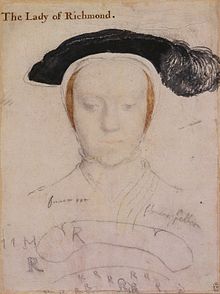
Mary FitzRoy, Duchess of Richmond and Somerset (c. 1519 – 7 December 1557), born Mary Howard, was a daughter-in-law of King Henry VIII of England, being the wife of his illegitimate son Henry FitzRoy, 1st Duke of Richmond and Somerset.

Mary FitzRoy, Duchess of Richmond and Somerset (c. 1519 – 7 December 1557), born Mary Howard, was a daughter-in-law of King Henry VIII of England, being the wife of his illegitimate son Henry FitzRoy, 1st Duke of Richmond and Somerset.
This section needs additional citations for verification .(December 2022) |

Mary was born in 1519, being the third of five children of Thomas Howard, then Earl of Surrey, and his wife Lady Elizabeth Stafford. His paternal grandparents were Thomas Howard, 2nd Duke of Norfolk and Lady Elizabeth Tilney, and his maternal grandparents were Edward Stafford, 3rd Duke of Buckingham and Lady Eleanor Percy. Her older siblings were Henry born 1517 and Katherine born 1518, [1] and her younger siblings were Thomas born 1520 and Muriel, born in 1521. [1] At the time of her birth, her father was the third-highest-ranking and most powerful nobleman in England. Her grandfathers, Thomas Howard, 2nd Duke of Norfolk and Edward Stafford, 3rd Duke of Buckingham were the most powerful peers in the Kingdom. After Buckingham's execution for treason in 1521, her grandfather was one of only two dukes in the Kingdom, (the other being Charles Brandon, 1st Duke of Suffolk). When her paternal grandfather died in May 1524, Mary's father became the new Duke of Norfolk. This changed in 1525, when Henry VIII elevated Henry FitzRoy, his six-year-old illegitimate son by Elizabeth Blount, to the Dukedom of Richmond and Somerset. When in 1529 Cardinal Wolsey, who was charged with FitzRoy's care, fell from grace the mantle passed to Thomas Howard. At the same time the idea arose, allegedly from either the King or Anne Boleyn, [2] that FitzRoy should marry Norfolk's daughter.
Four years later, in November 1533, negotiations were completed and Mary, now aged thirteen or fourteen, and FitzRoy, himself just fourteen, were married. Through her father, she was first cousin to both Anne Boleyn and Catherine Howard, as well as second cousin to Jane Seymour.
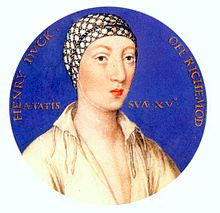
The match was a triumph for the Boleyn family as the Duchess was a former member of Queen Anne's household, and a staunch advocate of reform. It was also a very advantageous match for the Duchess as with no legitimate male heir to the throne, the Duke was seen at the time as a likely future king. However, the marriage was not to last as FitzRoy died of consumption on 23 July 1536. He had barely turned seventeen.
Fearful that sexual activity too early was unhealthy, the King had ordered the couple not to consummate their marriage.[ citation needed ] As a result, the Duchess was not allowed to keep many of the lands which would normally have been her entitlement as widow: the King insisted without the consummation,[ citation needed ] it was not a true marriage. She remained at court, closely associated with FitzRoy's cousin, Margaret Douglas. Together they were the main contributors to the Devonshire Manuscript, a collection of poetry from themselves and court poets. [3] The Duchess is thought to be the owner or holder of the manuscript; it is not known how much she contributed, however she is thought to have copied in one of her brother's poems "O Happy Dames." [4] In 1539, Douglas and the Duchess were appointed to meet Anne of Cleves at Calais. [5]
In 1542, when Henry VIII's fifth wife and the Duchess's first cousin Catherine Howard fell from grace, the Duchess and her entire family were arrested and briefly imprisoned in the Tower of London. The Duchess's father petitioned for her to be married to Thomas Seymour, brother of Henry VIII's third wife Jane Seymour. [2] The King gave his approval for the match, but her brother, Henry, Earl of Surrey, objected strongly, as did the Duchess herself; and the marriage did not take place. Surrey then suggested that the Duchess should seduce the aged King, her father-in-law, and become his mistress, to "wield as much influence on him as Madame d'Etampes doth about the French King". The Duchess, outraged, said she would "cut her own throat" rather than "consent to such villainy". [6] She and her brother fell out, and she later laid testimony against Surrey that helped lead to his trial and execution for treason in January 1547. Sympathetic to the Reformation, she engaged John Foxe as tutor for her brother's children.

The Duchess never remarried and her presence at court dwindled not long after Henry VIII died in January 1547. She died in December 1557, during the reign of her sister-in-law, Queen Mary I.
Though the Duchess has not been portrayed in any film or television programme thus far, she was mentioned in the second episode of the 2021 miniseries Anne Boleyn in a scene between Anne and her uncle Thomas Howard where they discuss his daughter's marriage to Henry FitzRoy that has not yet been consummated.
She has appeared in many books of noted historical fiction, most notably The Secrets of the Tudor Court by Darcey Bonnette which features Mary as the main character, and The Sixth Wife , in which she is a rival of Catherine Parr, and is used by her brother Surrey to try to become a "seventh wife" of the King despite her protests. Her character mainly falls into the background toward the end of the novel after the king has died. She is also featured in Queen's Gambit, a novel about Catherine Parr and is featured as one of Catherine's rivals. Mary was also the main character and story-teller in Brazen by Katherine Longshore.
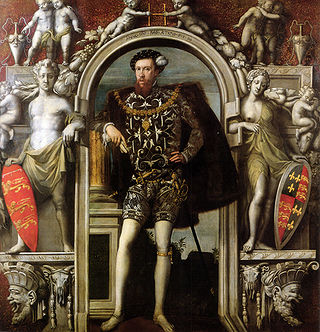
Henry Howard, Earl of Surrey, KG was an English nobleman, politician and poet. He was one of the founders of English Renaissance poetry and was the last known person to have been executed at the instance of King Henry VIII. His name is usually associated in literature with that of the poet Sir Thomas Wyatt. Owing largely to the powerful position of his father Thomas Howard, 3rd Duke of Norfolk, Henry took a prominent part in court life, and served as a soldier both in France and in Scotland. He was a man of reckless temper, which involved him in many quarrels, and finally brought upon him the wrath of the ageing Henry VIII. He was arrested, tried for treason and beheaded on Tower Hill.
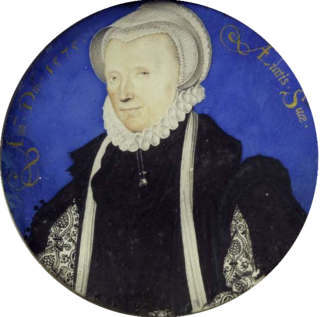
Margaret Douglas, Countess of Lennox, was the daughter of the Scottish queen dowager Margaret Tudor and her second husband Archibald Douglas, 6th Earl of Angus, and thus the granddaughter of Henry VII of England. She was the grandmother of James VI and I.

Thomas Howard, 2nd Duke of Norfolk, styled Earl of Surrey from 1483 to 1485 and again from 1489 to 1514, was an English nobleman, soldier and statesman who served four monarchs. He was the eldest son of John Howard, 1st Duke of Norfolk, by his first wife, Catharina de Moleyns. The Duke was the grandfather of both Queen Anne Boleyn and Queen Katherine Howard and the great-grandfather of Queen Elizabeth I. In 1513, he led the English to victory over the Scots at the decisive Battle of Flodden, for which he was richly rewarded by King Henry VIII, then away in France.

Thomas Howard, 3rd Duke of Norfolk, was a prominent English politician and nobleman of the Tudor era. He was an uncle of two of the wives of King Henry VIII, Anne Boleyn and Catherine Howard, both of whom were beheaded, and played a major role in the machinations affecting these royal marriages. After falling from favour in 1546, he was stripped of his dukedom and imprisoned in the Tower of London, avoiding execution when Henry VIII died on 28 January 1547.

Thomas Howard, 4th Duke of Norfolk,, was an English nobleman and politician. He was a second cousin of Queen Elizabeth I and held many high offices during the earlier part of her reign.

Elizabeth Blount, commonly known during her lifetime as Bessie Blount, was a mistress of Henry VIII of England.

Henry FitzRoy, Duke of Richmond and Somerset was the son of Henry VIII of England and his mistress Elizabeth Blount, and the only child born out of wedlock whom Henry acknowledged. He was the younger half-brother of Mary I, as well as the older half-brother of Elizabeth I and Edward VI. Through his mother, he was the elder half-brother of Elizabeth, George, and Robert Tailboys. His surname means "son of the king" in Norman French.

In common parlance, the wives of Henry VIII were the six queens consort of King Henry VIII of England between 1509 and his death in 1547. In legal terms, Henry had only three wives, because three of his marriages were annulled by the Church of England. He was never granted an annulment by the Pope, as he desired, however, for Catherine of Aragon, his first wife. Annulments declare that a true marriage never took place, unlike a divorce, in which a married couple end their union. Along with his six wives, Henry took several mistresses.
Lord Thomas Howard was an English courtier at the court of King Henry VIII. He is chiefly known for his marriage to Lady Margaret Douglas (1515–1578), the daughter of Henry VIII's sister, Margaret Tudor, for which he was imprisoned in the Tower of London, where he died on 31 October 1537. The affair is referenced in a verse by his nephew, the poet Henry Howard, Earl of Surrey.

The Boleyn Inheritance is a novel by British author Philippa Gregory which was first published in 2006. It is a direct sequel to her previous novel The Other Boleyn Girl, and one of the additions to her six-part series on the Tudor royals. * The novel is told through the first-person narratives of – Anne of Cleves, Katherine Howard, and Jane Boleyn, who was mentioned in The Other Boleyn Girl. It covers a period from 1539 until 1542 and chronicles the fourth and fifth marriages of King Henry VIII of England.
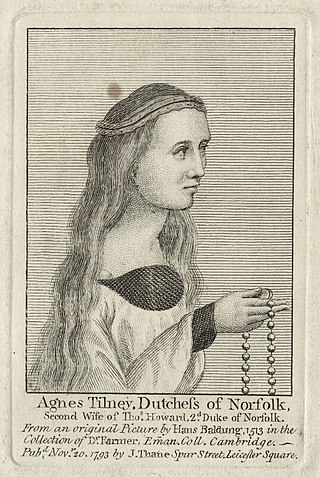
Agnes Howard was the second wife of Thomas Howard, 2nd Duke of Norfolk. Two of King Henry VIII's queens were her step-granddaughters, Anne Boleyn and Katherine Howard. Catherine Howard was placed in the Dowager Duchess's care after her mother's death.
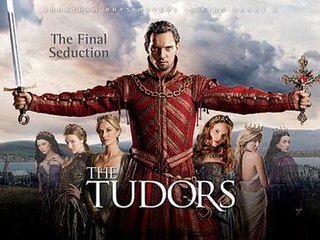
The Tudors is a historical fiction television series set primarily in 16th-century England, created and written by Michael Hirst and produced for the American premium cable television channel Showtime. The series was a collaboration among American, British, and Canadian producers, and was filmed mostly in Ireland. While named after the Tudor dynasty as a whole, it is based specifically upon the reign of King Henry VIII.

Henry VIII is a two-part British television serial produced principally by Granada Television for ITV from 12 to 19 October 2003. It chronicles the life of Henry VIII of England from the disintegration of his first marriage to an aging Spanish princess until his death following a stroke in 1547, by which time he had married for the sixth time. Additional production funding was provided by WGBH Boston, Powercorp and the Australian Broadcasting Corporation.
Sir William Stafford, of Chebsey, in Staffordshire was an Essex landowner and the second husband of Mary Boleyn, who was the sister of Anne Boleyn and one-time mistress of King Henry VIII of England.

Frances Howard, Countess of Surrey was the second daughter and third child of John de Vere, 15th Earl of Oxford, and Elizabeth Trussell. She first married Henry Howard, Earl of Surrey, and second Thomas Steyning.
Lady Elizabeth Stafford was an English aristocrat. She was the eldest daughter of Edward Stafford, 3rd Duke of Buckingham and Lady Eleanor Percy. By marriage she became Duchess of Norfolk. Her abusive marriage to Thomas Howard, 3rd Duke of Norfolk, created a public scandal.

Mary Boleyn, also known as Lady Mary, was the sister of English queen consort Anne Boleyn, whose family enjoyed considerable influence during the reign of King Henry VIII.
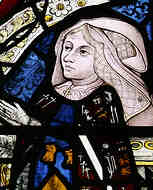
Elizabeth Tilney, Countess of Surrey was an English heiress who became the first wife of Thomas Howard, 2nd Duke of Norfolk. She served successively as a lady-in-waiting to two Queen consorts, namely Elizabeth Woodville, wife of King Edward IV, and later as Lady of the Bedchamber to that Queen's daughter, Elizabeth of York, the wife of King Henry VII. She stood as joint godmother to Princess Margaret Tudor at her baptism.

Catherine Howard, also spelt Katheryn Howard, was Queen of England from 1540 until 1541 as the fifth wife of King Henry VIII. She was the daughter of Lord Edmund Howard and Joyce Culpeper, a cousin to Anne Boleyn, and the niece of Thomas Howard, 3rd Duke of Norfolk. Thomas Howard was a prominent politician at Henry's court, and he secured her a place in the household of Henry's fourth wife, Anne of Cleves, where she caught the King's interest. She married him on 28 July 1540 at Oatlands Palace in Surrey, just 19 days after the annulment of his marriage to Anne. He was 49, and she was between 15 and 21 years old, though it is widely accepted that she was 17 at the time of her marriage to Henry VIII.
Anne Bourchier, Baroness Dacre was an English noblewoman, the wife of Sir Thomas Fiennes, 8th Baron Dacre. Her stepfather was Thomas Howard, Earl of Surrey, which made Queen consort Anne Boleyn, the second wife of King Henry VIII of England, her niece. Her son-in-law was Henry Norris, who was executed for treason in 1536, as one of the alleged lovers of her niece, Queen Anne.